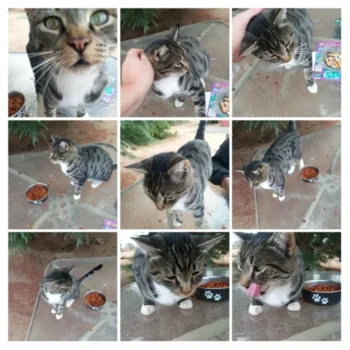It’s a common dilemma for cat owners – to keep your feline friend indoors or let them roam free in the great outdoors? For California Spangled cats, this decision becomes even more complicated. However, regardless of whether your furry friend is an indoor or outdoor cat, effective house training is key to a happy and healthy relationship with your pet. In this comprehensive guide, we will explore the step-by-step process of house training for both indoor and outdoor California Spangled cats. So whether your cat is already a seasoned indoor or outdoor adventurer or you’re just starting, keep reading to learn valuable tips and tricks for successful house training that will keep your cat happy and give you peace of mind.
Indoor Cats

Training your California Spangled cat to use their litter box is an essential part of keeping them healthy and happy. While outdoor cats may naturally gravitate towards outdoor spaces, indoor cats need to be taught where to go. In this section, we’ll cover the step-by-step process of house training your indoor California Spangled cat. From establishing a designated area to using positive reinforcement, we’ve got you covered with effective strategies for teaching your feline friend where to go. So, whether you have a new California Spangled kitten or an adult cat who needs a refresher on litter box training, keep on reading for valuable insight.
1.1 Establish a designated area
One of the most important steps in house training your indoor California Spangled cat is to establish a designated area for them to use as their bathroom. This can be a specific room in your house or a corner of a room where a litter box and/or potty pads can be placed. It’s essential to choose an area that is easily accessible for your cat, but also one that’s not in the middle of heavy traffic or close to their food and water sources.
When setting up the designated area, consider using a litter box with low sides to make it easier for your cat to access, especially if they are a kitten or have mobility issues. Place a comfortable mat or rug under the litter box to catch any litter or urine that may scatter or spill. Keep in mind that your cat will need enough space to move around and dig in the litter box comfortably.
If you choose to use potty pads, place them in the designated area and make sure they are easily accessible and secure. It’s essential to use pads that are large enough for your cat and that can contain any liquids effectively. Regularly replace soiled pads to keep the designated area clean and odor-free.
Once you have established a designated area, avoid moving it unless absolutely necessary. Consistency is vital when it comes to house training, and your cat will become confused and potentially refuse to use the area if it’s moved around frequently. Remember to keep the area clean and well-maintained to encourage your cat to use it consistently.
If you need more information on house training a California Spangled cat, take a look at our house training guide.
1.2 Consistency is key
Consistency is key in house training your California Spangled cat, especially when it comes to litter box training for indoor cats. Once you have established a designated area for your cat to do their business, it’s important to consistently direct them to that area. Do not confuse your cat by changing the location of their litter box or designated area. It is recommended to have one litter box per cat in multiple locations throughout your home.
Keep in mind that cats are creatures of habit and they thrive on routine. It’s important to feed your cat at the same time every day to encourage them to have a regular bathroom schedule. If your cat has an accident outside of their designated area, do not punish them. Instead, clean the area thoroughly and positively redirect your cat to their designated area.
For outdoor cats, consistency is also important in terms of their safe enclosed area. Ensure that the area is secure and free from potential hazards that could harm your cat. Train your cat to only use this designated area for their business, and make sure to consistently clean and maintain the area.
Consistency is a crucial component in house training your California Spangled cat, both indoor and outdoor. By maintaining a routine and positive reinforcement, you can successfully train your cat to use their designated area for their bathroom needs and avoid any potential accidents or behavioral issues. For more tips on house training your kitten or cat, check out our other articles on litter box problems and clicker training.
1.3 Positive reinforcement
When it comes to house training your California Spangled cat, positive reinforcement is an effective method that will encourage your furry friend to use the designated area. This is a process that can be done easily with treats, toys and kind words. By rewarding your cat when they use the litter box or outdoor area, they will associate positive emotions with the behavior, making them more likely to repeat it. Here are some effective positive reinforcement methods to try:
- When your cat uses the litter box or designated outdoor area, immediately offer them a treat as a reward. Use small treats, so as to avoid overfeeding and the development of excess weight.
- Giving your cat lots of positive attention and encouragement when they use the correct area will help build a strong bond between you and your pet.
- Use a clicker or a consistent verbal cue such as “Good boy!” or “Good girl!” in a high-pitched, happy voice when your cat behaves correctly. This is a great way to combine verbal and audible positive reinforcement.
- Offer your cat toys or play with them after they have used the litter box or designated area. This will encourage them to associate the appropriate behavior with fun and enjoyable times.
Remember, positive reinforcement is one of the most important tools in house training your California Spangled cat and will help build a healthy, happy and lasting bond. By consistently following these tips, you’ll be well on your way to a well-trained and obedient pet that you can be proud of.
If you want more information about house training your California Spangled kitten, check out our house training guide.
1.4 Litter Box Training Tips
When it comes to litter box training for indoor California Spangled Cats, there are a few key tips to keep in mind. Here are some litter box training tips that can help simplify the process:
| Tips | Explanation |
|---|---|
| Choose the right litter box | Make sure you get a litter box that is the right size for your cat, with low sides that your cat can easily step over. |
| Put the litter box in the right place | Put your litter box in a quiet, low-traffic, and odor-free area so that your cat can use it comfortably without being disturbed. |
| Keep the litter box clean | Cats are clean animals, and they won’t use a litter box that’s dirty. Scoop the box daily and change the litter once a week. |
| Provide enough litter boxes | A general rule of thumb is to have one litter box per cat, plus one extra. This ensures that there is always a clean litter box available. |
| Use the right type of litter | Experiment with different types of litter to see which one your cat prefers. Avoid scented litters, as cats can be sensitive to the added fragrances. |
| Understand your cat’s preferences | Observe your cat’s litter box habits to see if they prefer covered or uncovered boxes, or a certain type of litter. |
By following these litter box training tips, you can help your indoor California Spangled Cat feel comfortable using the litter box, which can help prevent accidents around the house. Remember that consistency and positive reinforcement are key to successful litter box training.
Outdoor Cats

As exciting as it is for your California Spangled cat to explore the great outdoors, it is important to ensure their safety. Outdoor training can be more complex than indoor training, as there are more variables to consider. However, with proper planning and consistency, your beloved feline can thrive outdoors. Here are some key tips to help ensure that your outdoor training is successful.
2.1 Enclose a safe area
When it comes to house training an outdoor California Spangled cat, it’s important to provide a safe and enclosed area for them to do their business in. This will not only give them a sense of security, but also prevent them from wandering too far from home. Here are some steps to follow when enclosing a safe area for your cat:
1. Determine the location: Look for an outdoor area in your yard which is relatively sheltered, and away from any potential hazards such as busy roads or water sources.
2. Choose the type of enclosure: There are various types of enclosures available, such as a fenced-in area, a screened-in patio, or a cat run. Consider the size of your cat and the available space when choosing.
3. Prepare the enclosure: Make sure the enclosure is free from any sharp objects or potential dangers that could harm your cat. Provide your cat with a sheltered area, such as a small house or covered area, where they can retreat to in case of bad weather.
4. Provide access: Create an entrance for your cat to access the area. This could be a small pet door or a gate which can be easily opened.
5. Encourage exploration: Introduce your cat to the enclosed area gradually, starting with short periods of time at first. Leave toys and treats in the area to encourage exploration and reinforce positive associations with the space.
By enclosing a safe area for your outdoor California Spangled cat to do their business in, you’re not only training them to use a designated area, but also providing them with a sense of security and protection.
2.2 Train your cat to use a designated area
The California Spangled cat is an intelligent and curious feline that loves spending time outdoors. However, outdoor cats should be trained to use a designated area to prevent them from causing damage to lawns or gardens. The following table outlines the steps to train an outdoor California Spangled cat to use a designated area:
| Step | Description |
| Step 1 | Choose a designated area for your cat to use as their bathroom. This could be a small corner of your yard or a designated litter box. |
| Step 2 | Take your cat to the designated area frequently throughout the day, especially after meals and naps. This will help them associate the area with going potty. |
| Step 3 | Encourage your cat to use the designated area by offering treats and praise when they do. Positive reinforcement is key in this process. |
| Step 4 | Monitor your cat’s behavior while they are outside. If you catch them attempting to go potty in an undesignated area, immediately bring them to the designated area. |
| Step 5 | If your cat continues to go potty in undesignated areas, consider confining them to a smaller area of your yard or providing them with a litter box as an alternative. |
| Step 6 | Be patient with your cat during this training process. It may take time for them to understand what is expected of them, but with consistency and positive reinforcement, they will eventually learn to use the designated area. |
Training an outdoor California Spangled cat to use a designated area requires patience and consistency on the part of the owner. However, the benefits of having a designated area far outweigh the time and effort it takes to train your cat. Not only will you prevent them from causing damage to your property, but it will also keep them safe from potential hazards outside.
2.3 Consistency is key
In order to successfully house train your outdoor California Spangled cat, consistency is key. This means establishing a routine and sticking to it as closely as possible. The following table outlines some tips for maintaining consistency during the house training process:
| Tip | Explanation |
|---|---|
| Establish a routine | Cats thrive on routine, so establish set times for feeding, playtime, and outdoor time. Stick to these times as closely as possible to help your cat understand what is expected of them. |
| Use the same designated area | Designate a specific area of your yard for your cat to use as their outdoor bathroom. Encourage them to use this area consistently to help reinforce the training. |
| Be patient | Housetraining an outdoor cat can take time, so be patient and consistent with your training routine. Your cat will need time to adjust to their new routine and understand what is expected of them. |
| Consider using pheromone sprays or diffusers | Pheromone sprays or diffusers can help to reduce stress and anxiety in cats, which can be a common cause of litter box issues. Consider using these products in conjunction with your training routine. |
By following these consistency-related tips, you can help ensure that your outdoor California Spangled cat is successful in their house training efforts. Remember to be patient, encouraging, and consistent, and your cat will soon be fully house trained.
2.4 Positive reinforcement
Positive reinforcement is essential when it comes to training your California Spangled cat, whether it is an indoor or outdoor cat. One of the most effective ways to encourage your cat to use a designated area is through reward-based training. Here are some tips on how to positively reinforce your cat during the house training process:
- Use treats: Every time your cat successfully uses the designated area, give them a small treat as a reward. This positive reinforcement will encourage them to continue using the designated area.
- Positive feedback: When your cat successfully uses the designated area, offer praise in the form of petting and verbal cues. This positive feedback will reinforce good habits and encourage further good behavior.
- Consistency: Consistency is key when it comes to positive reinforcement. Make sure to reward your cat every time they successfully use the designated area. This will ensure that they associate good behavior with rewards.
- Punishment-free: It’s important to avoid punishment while training your cat. Negative reinforcement, such as scolding or physical punishment, can cause lasting damage to your cat’s trust and well-being.
- Patience: Just like with any training, results may not be instant. Be patient with your cat and give them time to develop good habits. With consistent positive reinforcement, your California Spangled cat will learn to use the designated area in no time.
By using positive reinforcement, you can create a healthy and happy environment for your California Spangled cat. With patience and consistency, you will build a strong bond with your pet and create a lifetime of good habits.
Troubleshooting
When it comes to house training your California Spangled cat, it’s important to remember that accidents happen. Even the most well-trained cats can make mistakes. When faced with issues during the training process, it’s important to troubleshoot the problem and find a solution that works best for both you and your feline friend. In this section, we will provide tips for troubleshooting common house training issues with indoor and outdoor cats.
3.1 Accidents Happen
It’s important to remember that accidents are bound to happen, no matter how well-trained your California Spangled cat is. When it does happen, it’s important to clean the area thoroughly with an enzymatic cleaner to eliminate any trace of scent that may attract your cat back to the same spot. When cleaning up, make sure to wear gloves and avoid ammonia-based cleaners, as the smell of ammonia is similar to cat urine and may attract your cat back to the spot.
Here are some steps to take if accidents do occur:
- Remove your cat from the area immediately and put them in their designated area.
- Thoroughly clean up the area with an enzymatic cleaner.
- Use positive reinforcement to encourage your cat to use their designated area instead.
- If accidents continue to happen, consult with your veterinarian, as it may be a sign of an underlying medical issue or behavioral issue.
Remember to remain patient and consistent with your training. It may take some time for your California Spangled cat to fully grasp the concept of indoor or outdoor house training, but with consistency, positive reinforcement, and patience, accidents should become less frequent over time.
3.2 Behavioral Issues
Cats can develop behavioral issues related to their house training. One common issue is marking their territory, which involves urinating on surfaces to mark them as their own. This can happen even if the cat has been litter box trained. To prevent this, spaying or neutering your cat can often be effective.
Another common behavioral issue is fear or anxiety-related accidents. If your cat is scared or anxious, they may have accidents outside of their designated area. To address this, try to identify and eliminate any sources of anxiety, such as loud noises or other pets in the household.
In some cases, house training issues can be related to a lack of stimulation or exercise. Ensuring that your cat has plenty of opportunities to play and explore can help decrease their stress levels and prevent accidents.
It’s important to address any behavioral issues related to house training as quickly as possible to prevent them from becoming long-term habits. Consider consulting with a veterinarian or animal behaviorist for guidance if you’re having difficulty resolving your cat’s house training issues.
Conclusion
In conclusion, whether you have an indoor or an outdoor California Spangled cat, house training can be a challenging task. However, by following the steps and tips provided in this article, you can make the process easier and more effective.
For indoor cats, it is essential to establish a designated area for your cat to use as a bathroom, be consistent with your training, use positive reinforcement, and keep the litter box clean.
Outdoor cats require a safe enclosed area to prevent them from wandering off and getting lost or injured. Training them to use a designated area takes patience and consistency, as well as positive reinforcement when they use the designated area.
Despite your best efforts, accidents can happen during the house training process. In these situations, it is important to clean up the mess thoroughly, show patience, and not punish your cat, as this can lead to behavioral issues.
By following the guidelines described in this article and taking a loving and patient approach, you can successfully house train your California Spangled cat, whether they are indoor or outdoor. With patience and persistence, you and your furry friend will develop a strong bond, and your cat will be happy and healthy in their new home.
Frequently Asked Questions
1. Can California Spangled Cats be house trained to use a litter box?
Yes, with patience and consistency, California Spangled Cats can be trained to use a litter box.
2. Do indoor cats have different house training needs than outdoor cats?
Yes, indoor cats require litter box training, while outdoor cats need to be trained to use a designated outdoor area.
3. What is the best way to establish a designated area for house training an indoor California Spangled Cat?
Choose a quiet, low-traffic area of the house and set up the litter box there consistently.
4. Can positive reinforcement be used to house train California Spangled Cats?
Yes, positive reinforcement is a great way to encourage your cat to use the designated area for elimination.
5. Should I let my outdoor California Spangled Cat roam free or should I enclose a safe area for them?
It is safest to enclose a designated outdoor area for your cat to prevent them from getting injured or lost.
6. How can I train my outdoor California Spangled Cat to use a designated area for elimination?
Place the litter box in the designated area and encourage your cat to use it consistently. Use positive reinforcement when they do.
7. What should I do if my California Spangled Cat has an accident indoors?
Clean up the mess thoroughly to remove the scent, and retrain your cat to use the designated area for elimination.
8. What are some common behavioral issues when house training California Spangled Cats?
Some behavioral issues that may arise include inappropriate elimination, scratching furniture, and aggression.
9. Can I train my California Spangled Cat to only use a litter box and not eliminate outside?
Yes, with consistency and patience, it is possible to train your cat to only use the designated area for elimination.
10. How important is consistency when house training California Spangled Cats?
Consistency is crucial when house training California Spangled Cats, as it helps establish good habits and routines.







